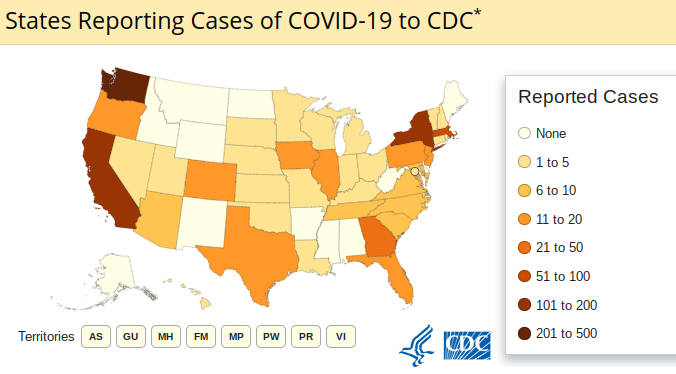OK, Gen Z: It’s time to save our Boomers.
A map of the COVID-19 outbreak in the United States.
March 12, 2020
Today, our newspaper’s adviser pulled us aside. He said he understands that we have a magazine coming out soon. He said he’s aware of our commitment to student journalism. But he also said that, with the COVID-19 pandemic, those things don’t quite matter anymore, not for now.
He said we need to shift our priorities, and we chuckled. Of course we do, of course we will, we responded, but we were still imagining “flat nights” in a few weeks — where our whole staff works on the paper together after school — discussing story angles with our writers every day and ultimately publishing articles per usual.
Our adviser pulled out a piece of paper. “If you fold this paper 42 times, it will reach the moon,” he said. “Its length multiplies exponentially with each fold. It’s the same with COVID-19. It will multiply exponentially. Black & White should not be your number one priority.”
Then we got it.
The United States is graduating nurses early to accommodate for the shortage of medical experts. German Chancellor Angela Merkel said it’s likely that 70% of the German population will contract the virus, along with countless others across the globe. The NBA suspended its season. The stock market plunged seven percent since this morning after a volatile few weeks that saw a more than 20% drop from its peak, qualifying as a bear market.
And we’re all two weeks behind this virus, with investigators contacting people who may have contracted it at times they barely remember, interacting with people they barely knew, sending off new patients into the world to interact with more people without those patients knowing they themselves now are contagious. We don’t know how bad it can get.
In a Washington Post interview, one former director at the Centers for Disease Control and Prevention predicted, “half the U.S. population would become infected and more than one million people would die.” Not all of us are affected equally: According to the World Health Organization, “Mortality increases with age.” Other virologists calculate the virus’ death rate at possibly as low as .1% for people under 30 — and possibly as high as 15% for those over 80.
Gen Z, we can’t turn the other way. Uninformed students in our classes laugh off the impacts and headlines, or don’t recognize the reality of the virus. Aside from cries of dry hands from aggressive washing, we treat the virus as a regular illness, akin to the flu. But it’s not the flu, and we don’t know enough about it to equate it to an annual, regulated illness. It’s new.
The situation may seem dire, and there’s likely not much we can do to stop the total number infected. But there are real steps we can take to at least postpone and slow the spread of this virus, giving our emergency rooms time to accommodate everyone. At the same time, nightmare anecdotes are coming out of Italy and other countries, where hospitals are stretched so thin — not just from the COVID-19, but also from still having to treat normal caseloads — that people are dying who, with adequate care, would not have. The social media campaign “flattening the curve” is making its rounds online as we type, encouraging people to have realistic expectations about the exponential severity of the virus, but at the same time employ earnest attempts at social distancing and slowing the spread in a way that gives our emergency rooms a chance.
So Gen Z, what can we do? We can stop sharing food, we can stop touching our faces and touching others. We can keep a 6-foot distance between ourselves and our peers. In an adolescence dominated by misinformation and cries of “fake news,” we can start trusting experts again — virologists and the like — when they appear on the news, locally, nationally and globally, because they’ve been right. We can postpone or cancel large events. We can close schools.
In fact, had we stopped more large gatherings from happening as planned, or closed schools preemptively, the risk of contracting coronavirus would have decreased. Close quarters have been, and will continue to be, a petri dish.
School closures in particular aren’t a cure-all, though — medical professionals may have trouble finding childcare, and officials should make attempts to provide solutions — but closures slow the spread, and saves lives.
Students may be concerned with grades, ACTs and the possible cancellation of this year’s Talent Show, but, again, we need to shift our priorities entirely. Let’s focus on our parents, teachers and relatives rather than our math tests and Spanish projects. We as students may not be at high risk, but our parents and grandparents certainly are. If this comes across as harsh and serious, it’s because it needs to.
Student journalism still has at least one more responsibility, at least for today. We hope this article provides a wake-up call, a warning, a way to inform and impact. Let’s do what we can to prevent the spread of the virus, and let’s remember to treat this as what it is: a new global pandemic, and in turn, a new paradigm.
The Black & White editorial staff
For more information on the COVID-19 pandemic, please refer to these resources:
Centers for Disease Control and Prevention
Montgomery County Public Schools
Montgomery County Department of Disease Control and Epidemiology — 240-777-1755
Maryland Department of Health and Infectious diseases — 410-767-6700











Sandy grundman • Mar 13, 2020 at 6:37 pm
So proud of you all. Right on. With kids like you there is great hope for the futurr